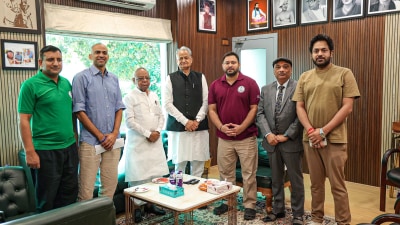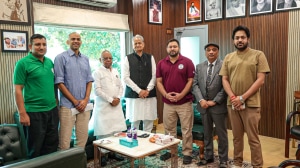Researchers create nanostructures,and whip up a recipe
Edible nanostructures discovered by Northwestern University researchers are made from food-grade compounds and have wide-ranging commercial applications
In the latest step in sciences never-ending quest for tinyness,researchers at Northwestern University have made edible nanostructures.
It tastes like starch, said Ronald A. Smaldone,a postdoctoral researcher at Northwestern,speaking of the material,made with a sugar,a salt and 190-proof grain alcohol. Kind of like a saltine cracker,I guess,without the salt.
The creations belong to a class of structures known as metal-organic frameworks (MOFs) that are rigid and porous. Individually,they are vanishingly small,but they stack together into cube-shape crystals several millimeters in size,large enough to see.
Other molecules could be placed in the hollow spaces,and potential applications include storing hydrogen in future fuel-cell cars,delivering drugs inside the body or using the pores as test tubes. These are materials where you can do legitimate chemistry inside of,and thats where our research program is heading right now, said Jeremiah J. Gassensmith,a member of the research team. Well be able to do nanoscale reactions inside of the crystal.
Because they are made from widely available compounds used in the food industry,the Northwestern nanostructures are cheaper and easier to make than previous metal-organic frameworks,which are generally synthesised out of petroleum products.
And they are edible,which could appeal to people who like very small portions,or to experimenting chefs. Metal-organic frameworks may not sound appetizing,but a metal,as defined by chemists,is simply an element that can easily become a positive ion. In this case,the metal was potassium,a nutrient that people need anyway.
The abstract for the scientific paper,to be published in November in the journal Angewandte Chemie,says,Take a spoonful of sugar (gamma-cyclodextrin to be precise),a pinch of salt (most alkali metal salts will suffice),and a swig of alcohol (Everclear fits the bill),and you have a robust,renewable,nanoporous (Langmuir surface area 1,320 square metres per gram) metal-organic framework for breakfast.
Gamma-cyclodextrin is a ring-shape sugar typically made from corn starch. The alkali metal salts included potassium chloride,a salt substitute,and potassium benzoate,a preservative. The Langmuir surface area is a measure of how much can be stored inside,which is a lot. The hollow pores make up more than half of the volume. The cyclodextrin and salt were dissolved in water. As the alcohol slowly evaporated into the solution,the colourless cubic crystals started to grow.
The nanostructures were discovered by accident. Working in the laboratory of J. Fraser Stoddart,a chemistry professor,Dr. Smaldone and Ross S. Forgan,grew the crystals as part of troubleshooting on a molecule they were trying to make.





- 01
- 02
- 03
- 04
- 05


























